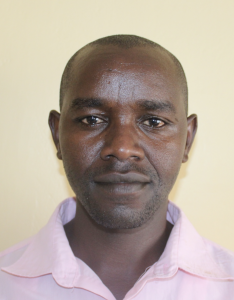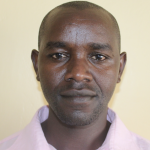March, 2020: Hobunaka Primary School Project Complete!
Hobunaka Primary School in Kenya now has access to a new source of safe, clean water thanks to the completion of their rain tank, which has the ability to collect 50,000 liters of water. We installed new latrines and handwashing stations for students, and we trained students and staff on improved sanitation and hygiene practices. All of these components work together to unlock the opportunity for these students to live better, healthier lives.
''As the sanitation teacher of this school, I am very grateful for your team for reaching our school. Indeed we've suffered long enough without water. This project will save us enough time now for the pupils to concentrate on their academics. As a sanitation teacher, my work is also made easier because water and sanitation go hand in hand. Indeed we are grateful," said Zachariah Okama.
Hobunaka Primary School has a "new" name, school members said, because the community around is now looking at them with more respect because of their new tank and latrines.

Students and staff celebrate the completed rain tank
Rain Tank
Construction for this 50,000-liter rain tank was successful!
Parents, staff, and students helped our artisans gather everything needed for construction. All the while, the school cooks prepared meals for the artisans, and the school provided accommodations for the artisans during their work. Local women and men helped our artisans with their manual labor, too.
The process officially began with our staff and school administration looking around the school compound to try and determine the best location for a new rain tank. This needed to be the best site with good, clean roofing to catch the rainwater.

Artisan inserts drainage pipe and tap into rain tank's concrete foundation
Then, we cleared the site by excavating the soil within the required measurements to make level ground for the tank foundation. The foundation was cast by laying hardcore on level ground and then reinforcing it using steel, concrete and waterproof cement.

Working on plaster inside the rain tank
Both the drawing pipe as well as the washout pipe were affixed as the foundation was laid. The wall was built with ferro-cement techniques through 6 layers. The inner wall was plastered while rough casting was done on the outer part. Finally, the catchment area was dug, plastered, and a short staircase installed.

Attaching dome structure to tank walls
Dome construction could begin after the superstructure had been given enough time to settle. The manhole cover was fitted, inlet pipes were connected to the roof gutters, inlet screens, ventilation pipes (breathers) and overflow pipes were all done to standard.
Once finished, the tank was given 3 weeks to undergo complete curing before it was cleaned and handed over to Hobunaka Primary School, though we will continue to offer them unmatchable support as a part of our monitoring and maintenance program.

A pupil enjoying water from the rain tank
VIP Latrines
This project funded the installation of 6 new ventilated improved pit (VIP) latrines, 4 for girls and 2 for boys since the girls had fewer latrines to start with than the boys. All of these new latrines have cement floors that are designed to be easy to use and clean. And with a rain tank right on school property, there should be enough water to keep them clean.

Girls stand in front of their new latrines with a handwashing station out front
Handwashing Stations
The 2 handwashing stations were delivered to the school and handed over to the student health club. These were placed outside of the girls’ and boys’ latrines to encourage handwashing after latrine use. Health club members teach other students how to properly wash their hands at the stations, make sure the stations are filled with water and work to ensure that there is always soap or ash available.

Handwashing
New Knowledge
Hygiene and sanitation training was scheduled with the help of the school principal, school Board of Management, and Head Teacher Rael Mutola, who together ensured that the training date would be convenient for students, staff, and parent representatives. Individual teachers helped by selecting students from each class to represent the others.
28 people attended training, including pupils, teachers, parents, and local leaders from the community, the school's church sponsor, and the government. The weather was so favorable as it was a sunny day. We met in the church that sponsors the school since the pastor was invited to be part of this training too. Based on the number of participants, the church was ideal for both the pupils and the board members. It was a conducive place for learning since the air was very good; the windows were big enough that they allowed in the fresh air. All of this affected training in a positive way.

A pupil demonstrates toothbrushing to her classmates
We covered a number of topics, including personal hygiene such as bathing, oral hygiene, and handwashing with soap as a barrier from germs; and operation and maintenance of the new facilities, with each person understanding their role for long-lasting clean water and good health. The new student health club will be greatly involved in project management and will be responsible for encouraging good health and hygiene practices amongst their peers, teachers, and the larger community.

Trainer Laura leads handwashing training
At the end of the training, the participants were divided into 2 groups. Facilitators Laura Alulu and Aclaine Agesa told the groups they were to give a summary of all that was learned during the entire training, and each group member had to contribute at least 1 point. The group with the most remembered points would win, and so it was like a competition. This really set the pupils into motion and inspired them to be more active. From the questions that were being asked and answered by the participants, it proved and assured us that the concepts were well captured and understood.

Trainer Laura checks in a group during the break-out session
"This training will help us because it has expounded and opened our eyes. It has also educated us on how to have a clean and healthy life and how to maintain and observe cleanliness. At least now, we will be able to improve the sanitation conditions in our lives thus curbing out diseases that are caused by poor sanitation and poor maintenance of water," said Sanitation Teacher Everlyne Owano.
Thank you for making all of this possible!


 Rainwater Catchment
Rainwater Catchment
 Rehabilitation Project
Rehabilitation Project
































